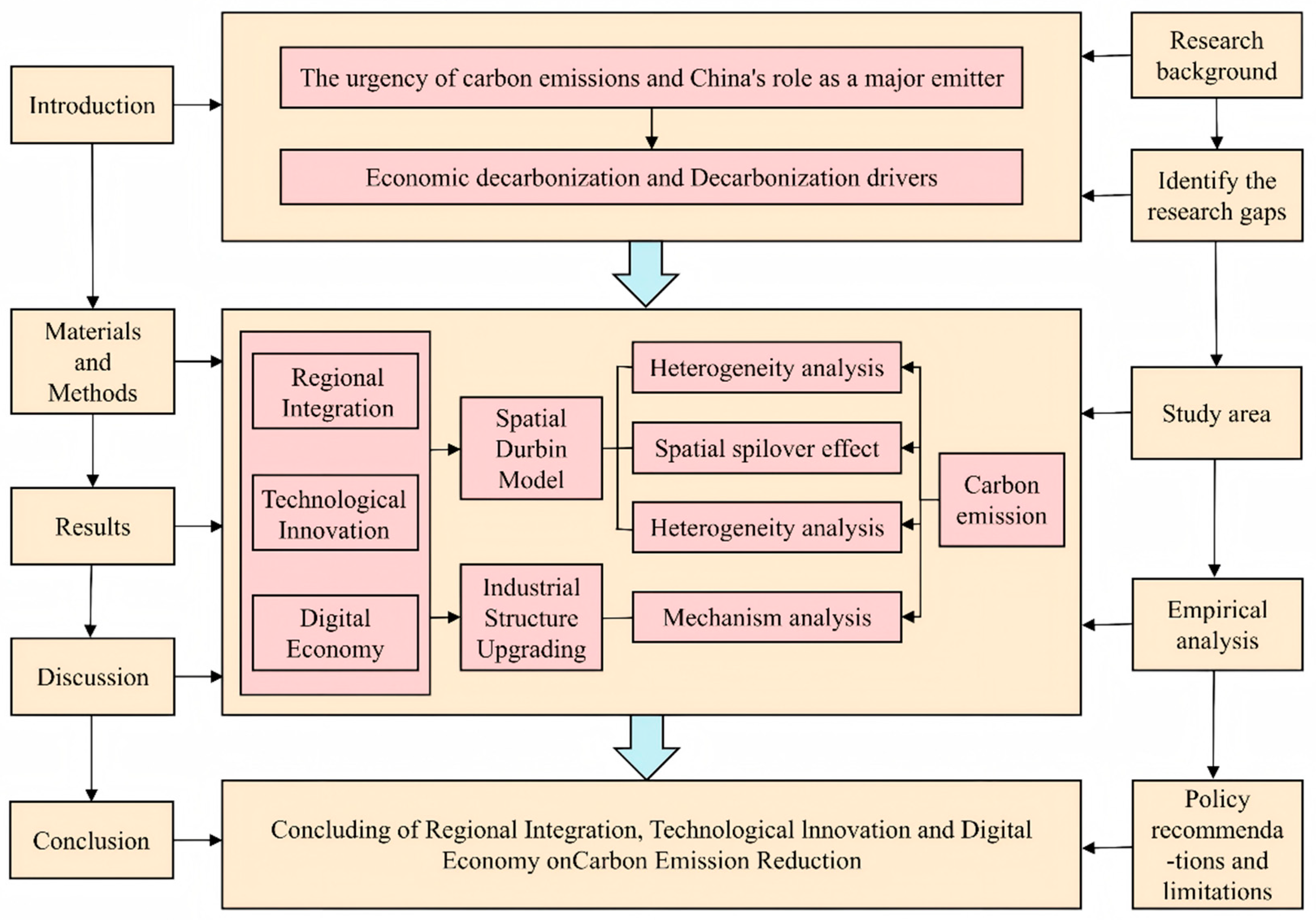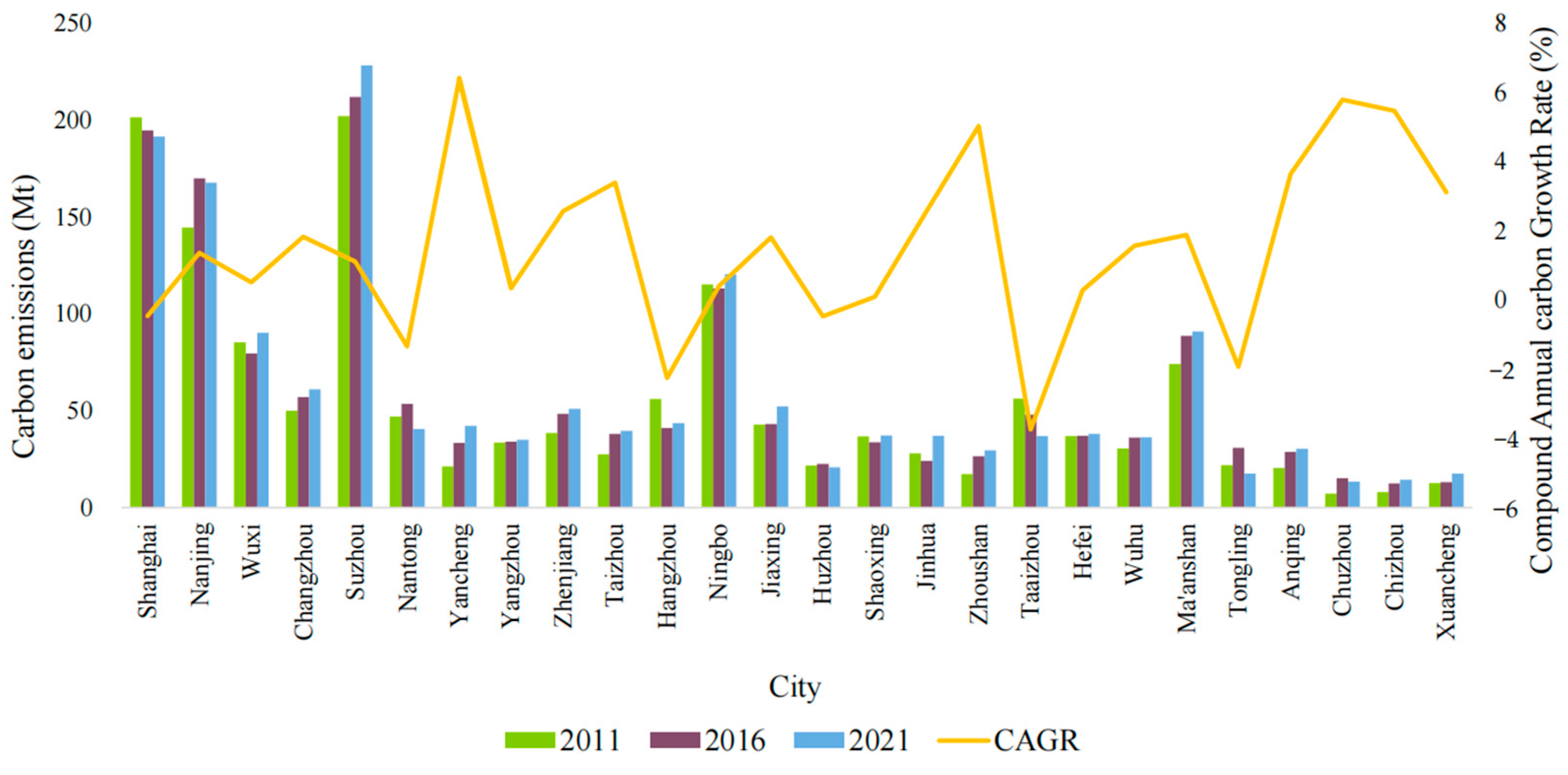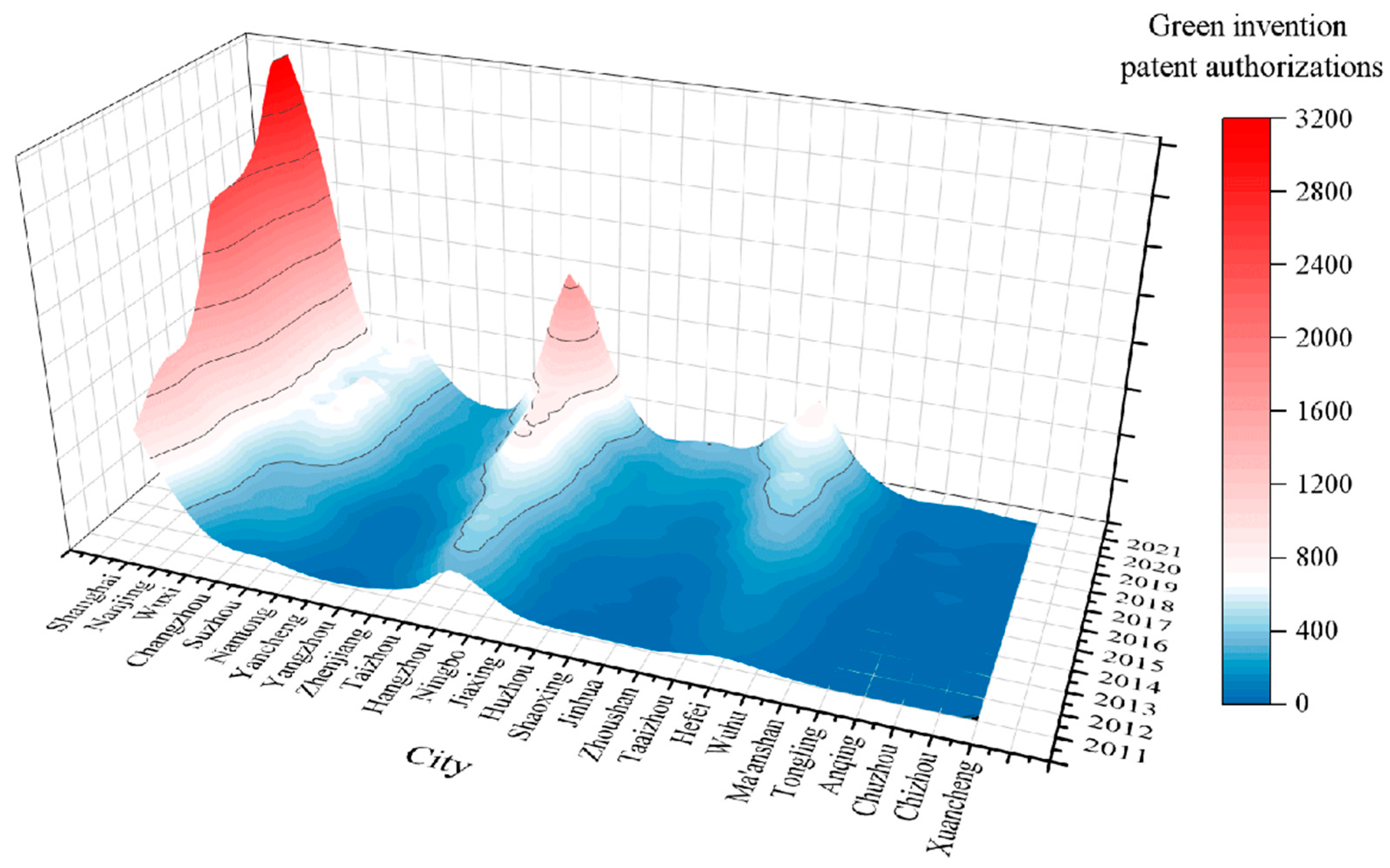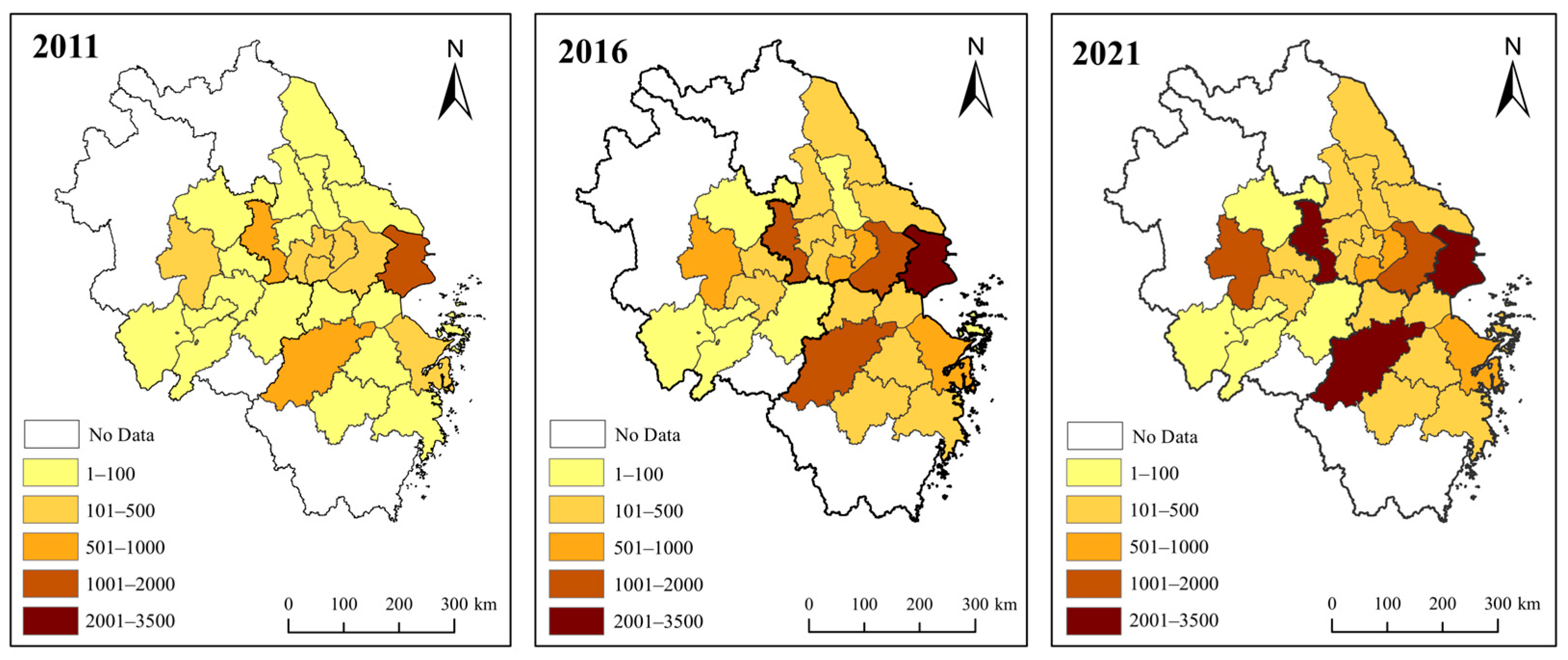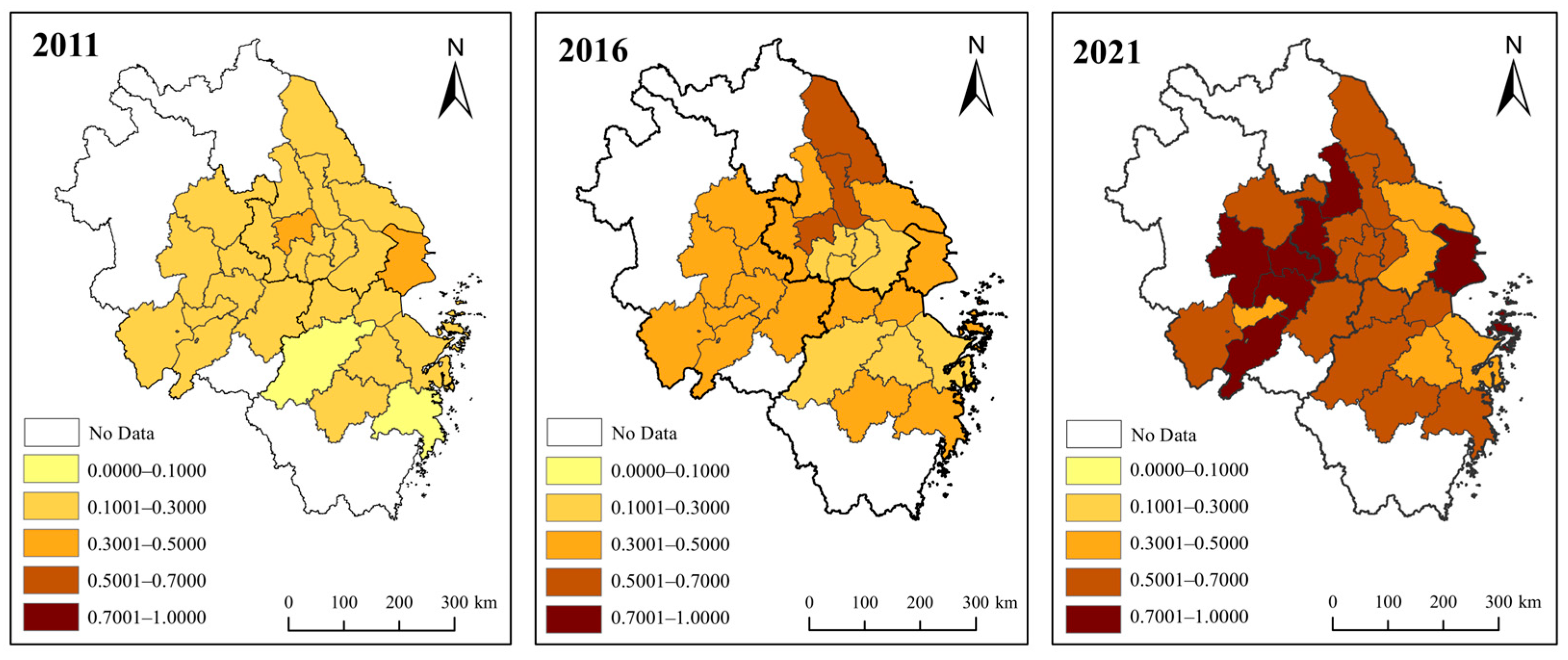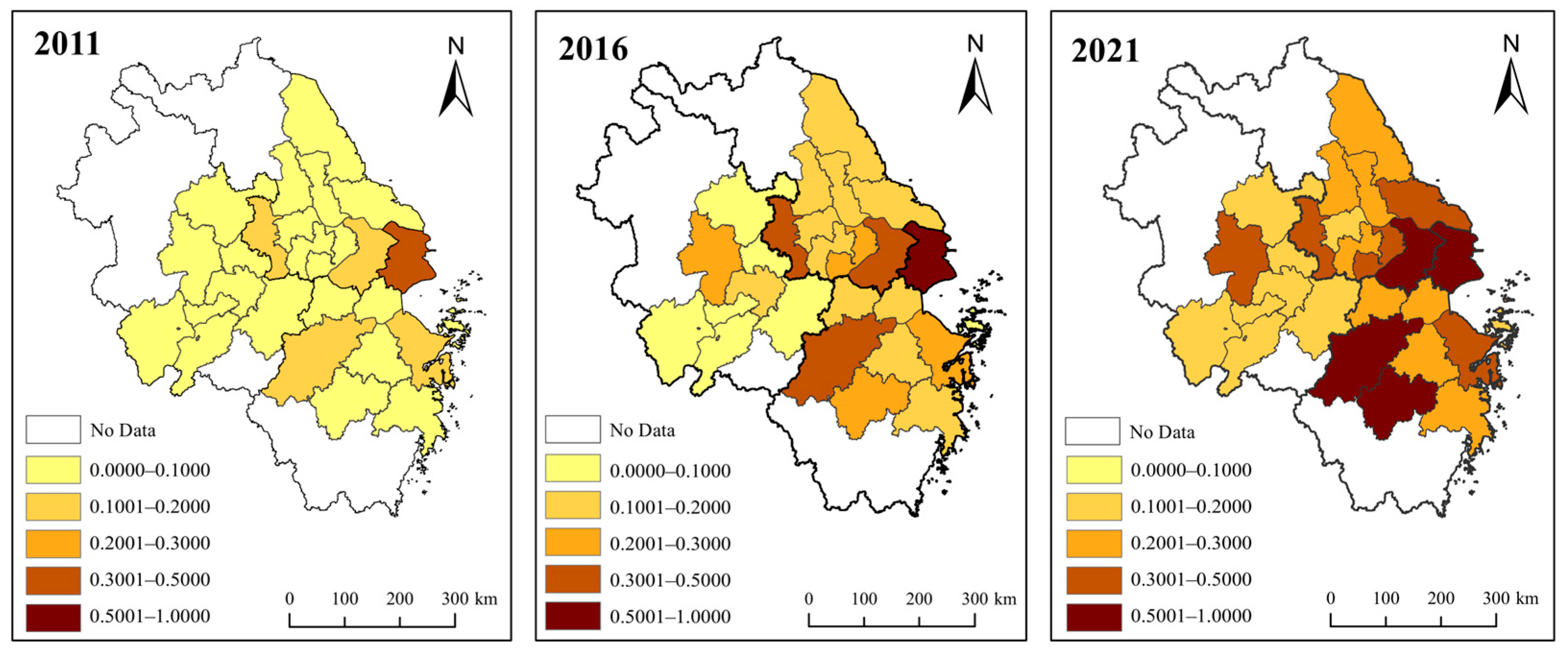4.1. Spatiotemporal Evolution Patterns of Decarbonization Drivers
Since the 21st century, carbon emission pressures have emerged as a critical challenge for developing nations, with China confronting analogous issues. While the country achieved rapid economic growth following its reform and opening-up policy, the extensive development model led to technological stagnation in production, the overexploitation of resources, and environmental degradation. Since 2007, the central government has promoted regional economic and ecological integration, implementing a series of policies to build a “Resource-saving and Environment-friendly Society”, to alleviate emission reduction pressures. This study reveals that the carbon abatement effect of RI exhibits “short-term effectiveness but long-term limitations”, partially aligning with the inverted-U-shaped hypothesis identified by Zhang et al. [
62]. The baseline regression results confirm its direct emission reduction effects, demonstrating that policy-driven resource integration facilitates decarbonization. RI provides a favorable environment for economically active and densely populated areas, facilitating the formation of economies of scale, enhancing enterprises’ capabilities to develop low-carbon technologies [
63,
64], and eliminating regional barriers to accelerate the diffusion of green technologies and management experiences [
65]. It encourages the utilization of comparative advantages under market competition and influences carbon emissions by fostering innovation networks [
66]. Notably, the YRD region has dedicated itself to ecologically friendly integrated development. By improving the convenience and sharing of public services, the government has enhanced public welfare and guided the adoption of green lifestyles. Environmental greening and governance have promoted green investment and consumption, while prioritizing public education has nurtured talent with sustainable development mindsets. Moreover, the spatial analysis reveals negligible and statistically insignificant spatial spillover effects from RI. This may stem from persistent administrative barriers and market fragmentation, coupled with divergent understandings and implementation approaches toward urban sustainability among local governments. Temporally, its long-term carbon reduction effect is weaker than its short-term impact. As integration progresses, an industrial structure lock-in effect may emerge, where energy-intensive industries form stable regional supply chains, weakening long-term emission reduction outcomes. In conclusion, the long-term development of RI is influenced by multiple factors [
67], and its sustained effectiveness depends on incorporating more ecological elements.
TI plays a pivotal role in accelerating green economic transitions. This study reveals that the spatiotemporal evolution of TI follows a “short-term cost versus long-term dividend” pattern. Although green innovation technologies are widely regarded as core decarbonization drivers [
68] capable of reducing emissions through production mode transformation and energy structure optimization [
69,
70,
71], our empirical results show that TI initially increases local carbon emissions through direct effects. Initial technological investment is often accompanied by the “inertial expansion” of traditional industries. This paradoxical outcome may stem from productivity expansion in traditional industries prioritizing economic output over ecological efficiency [
72], inadequate infrastructure for green technology adoption, and high costs of green innovation implementation triggering carbon rebound effects [
73], suggesting a time-lagged decarbonization impact of technological innovation. However, further analysis demonstrates TI’s substantially stronger long-term decarbonization potential and enhanced spatial spillover effects. Over extended periods, green technological innovation facilitates the growth of digital finance industries to achieve emission reduction–economic growth dual objectives [
54], while generating knowledge externalities that reduce cross-regional technology adoption costs through R&D spillovers. Inter-regional knowledge diffusion via labor mobility and corporate partnerships, particularly from high-R&D regions, enables broader technological dissemination. This evidence underscores the urgency to establish regional green technology trading platforms by leveraging patent sharing and joint R&D programs to dismantle innovation silos.
In China, DIE has emerged as a dynamic economic paradigm, flourishing alongside deepening RI and waves of TI. Unlike traditional systems reliant on massive fossil fuel consumption, DIE operates as a green, sustainable decarbonization driver [
45], potentially catalyzing the decoupling of economic growth from carbon emissions [
74,
75]. This study confirms that DIE’s emission reduction capacity strengthens with enhanced spatial coordination. While it initially increases local carbon emissions through short-term direct effects, DIE demonstrates a significant long-term decarbonization potential and suppresses neighboring cities’ emissions via negative spatial spillovers. Furthermore, there is a certain synergy between DIE and TI. DIE is highly dependent on TI, but the adoption and scaling of technology require a maturation period. In the early stage of its integration with traditional industries, it may trigger a “scale paradox”: on the one hand, the digital transformation of enterprises requires the deployment of a large number of hardware facilities such as servers and communication equipment, whose manufacturing and operation generate direct carbon emissions; on the other hand, the empowerment of traditional industries by digital technology may stimulate capacity expansion in the short term, such as e-commerce driving the growth of logistics and freight volume, indirectly pushing up energy demand. In the absence of renewed energy from intensive R&D activities [
76] and energy efficiency improvements from green technological innovations, DIE will lead to an undesirable increase in the output of traditional industrial products, instead promoting carbon emissions. The fact that the coefficient of DIE on carbon emissions is higher than that of TI in the direct effect results also confirms this point. This result is consistent with the “spatial imbalance” observation of Gu et al. [
77], and further points out that the digital economy can strengthen the spatial spillover of technological innovation through the “learning effect”, effectively promoting carbon emission reduction. Similarly, its “learning effect” depends on infrastructure and policy support. Without green innovation support, it is likely to become a tool for the expansion of traditional industries. Therefore, policies should promote the “bundled” investment in digital infrastructure and green technologies.
These findings provide us with more insights. TI and DIE are more advanced decarbonization driving forces, and their improvement in urban energy and economic structure needs constant attention. Carbon reduction requires the market to provide a new low-carbon economic transition, rather than relying solely on the government’s master plan for the region. For example, due to the constraints of urban spatial planning, there is a saturation value for public services and urban greening, which weakens public contribution to low-carbon actions, and the physiological activities of biological sources increase carbon emissions [
78].
4.2. Heterogeneity of Decarbonization Effects
The findings of this study exhibit significant heterogeneity based on the characteristics of urban development time, economic differences, and energy structures. Firstly, the temporal heterogeneity analysis reveals that RI initially increases urban carbon emissions. After the 19th National Congress of the Communist Party of China in 2017, cities in the YRD were influenced by policies promoting regional coordinated development. The enhanced regional cooperation led to increased energy demand, which, to some extent, resulted in higher urban carbon emissions. Additionally, following the implementation of relevant policies, high-pollution industries were transferred. Environmental pollution in the YRD’s central cities decreased, while that in the peripheral cities increased, potentially leading to an overall rise in the environmental pollution level [
79]. This further demonstrates the complexity of RI’s impact on carbon emissions: depending on government policies, pollutants, and the selection of research areas, the decarbonization effect of RI may yield opposite results [
67]. Guided by the “Digital China” policy, the emission-reducing effects of TI and DIE gradually emerged, and the three decarbonization drivers showed opposite impact characteristics. After 2017, cities in the YRD paid more attention to achieving their ecological construction goals through the development of DIE and a new round of technological revolution. However, competition among local governments was evident. The actions of neighboring cities to promote RI can improve the regional integration framework of the local city and lead to a greater focus on ecological benefits. Nevertheless, it is difficult to find a more appropriate synergy between TI and DIE in mitigating climate change and reduce carbon emissions.
Secondly, regarding the decarbonization performance of different city types, economically advanced cities demonstrate a greater capacity to achieve “dual carbon” goals, while energy-intensive cities are held back by their traditional energy structures. Economically developed cities (such as Shanghai and Hangzhou) have sufficient capital investment and strong technology absorption capabilities, making it easier for them to leverage their capital and technology advantages to unleash their decarbonization potential. However, there are few ways to further expand this effect. The decarbonization effects of energy-intensive cities (such as Xuzhou and Ma’anshan) are severely restricted by their traditional energy structures. Such cities need to prioritize the transformation of their energy structures rather than blindly pursue the expansion of DIE. This finding confirms the impact of economic development levels and energy structures on carbon emissions [
80] and further refines the analysis of differences among different city types in the decarbonization process. Policy formulation needs to be tailored to local conditions, and differentiated emission-reducing strategies should be formulated according to the characteristics of different cities.
4.4. Policy Recommendations and Limitations
It can be concluded that the development direction of economic decarbonization is consistent with the evolution trend of decarbonization driving forces. This means that the integration of traditional elements and policy incentives no longer dominates the process of carbon reduction but is replaced by active low-carbon technology applications and economic forms that can improve green growth rates. In light of these findings, several recommendations may be worth considering for policymakers: (1) To cultivate a conducive decarbonization environment for RI, market segregation and administrative barriers need to be removed from institutional mechanisms. Promoting the convenient sharing of public services in various fields and upgrading infrastructure conditions are also beneficial for the decarbonization effect of RI. For example, establishing a regularized information-sharing platform to disseminate timely information on policy dynamics and industrial development in the region, strengthen cooperation and communication among governments, and promote scientific and synergistic government decision-making. In respect of public services and infrastructure, new energy vehicle sharing services should be promoted, new energy vehicle leasing outlets should be increased, etc. More importantly, cities should bolster cooperative ecological environment preservation and administration so as to establish a green development base for RI. For instance, a cross-regional cooperation mechanism should be established for ecological protection and restoration projects and large-scale ecological restoration projects should be jointly carried out. Pollutant emission standards and treatment measures should be harmonized, and the development of clean energy should be promoted. A comprehensive carbon emissions trading system should be established. Low-carbon industries should be encouraged to become stronger and better. (2) Economic decarbonization cannot rely solely on the integration of traditional production factors and the improvement of resource allocation efficiency, but it needs to find long-term, competitive decarbonization driving forces. It is essential to integrate high-quality development elements like green TI and DIE across regions and sectors to serve the needs of “dual carbon” goals. For instance, this could be achieved by encouraging universities, research institutions, and enterprises to jointly carry out research on green technology innovation and promoting the application of digital technology in energy management, intelligent manufacturing, and other fields. For energy supply-intensive cities, it is recommended to implement targeted subsidies for green patents. For example, special funds should be established to support the transformation of patents related to clean coal utilization and industrial carbon capture technologies. The construction of a green patent sharing alliance in the YRD region should be promoted, allowing energy-intensive cities to obtain free access to the patent rights of core cities. Importantly, the government should establish a “non-zero-sum game” concept to synergistically develop and promote the positive spillover effects of green TI and DIE and avoid the regional “carbon leakage” phenomenon caused by the transfer of polluting industries. Establishing an environmental assessment mechanism for regional industrial transfers should be considered, and rigorous carbon emission assessments of industrial projects to be transferred should be conducted. In addition, UIS is a positive way to cultivate decarbonization potential. (3) Carbon emission reduction strategies in cities should be oriented toward sustainable development, follow the pattern of economic decarbonization, and reasonably formulate emission reduction targets and policy initiatives based on the heterogeneity of decarbonization driving forces in cities. Urban development should focus on synchronizing economic and ecological benefits. Cities at a disadvantage in RI should mobilize green production and consumption initiatives, aim for long-term carbon neutrality goals, introduce green technologies, and accelerate the creation and layout of low-carbon industrial development spaces. Specific measures include establishing citizen green consumption incentive mechanisms and setting up special funds for low-carbon technologies. A higher RI should be followed by a shift toward the exploration of emerging decarbonization technologies and economies. For example, to promote the sharing of advantageous resources such as emission-reducing and energy-saving technologies. Moreover, cities can support the digital and clean development of the energy industry, namely, by ensuring that the efficiency of the energy supply does not decline and by accelerating the low-carbon transition of the energy mix.
Finally, it is acknowledged that this article still faces some limitations. First, although this study made significant efforts to explore the evolution and effects of important drivers of decarbonization separately, according to urban development, it still could not address the specific limitations regarding coupled carbon reduction. Future research could further investigate the meaningful impacts from the coupled coordination theory perspective using more appropriate modeling and extend future research by delving into the interaction mechanisms between RI, TI, and DIE. Second, the time span of this study is only up to 2021, so the sample survey time should be updated and extended into the future to bring more current and relevant results to the study. The research method is mainly quantitative analysis, lacking a qualitative discussion of the details of policy implementation. Additionally, applying the theoretical framework or model to more urban agglomerations is necessary to assess its applicability and generalizability. Third, within the constraints of space and different research focuses, future research could also examine the impact of urban water pollution and solid waste management on carbon emissions. Other drivers from different perspectives are present, such as the direction of TI in the industry, the type of digitization, and the allocation and pricing of land, which can also affect decarbonization. This paper only explores UIS as the core mediating mechanism, without addressing diversified transmission pathways such as green finance, circular economy practices, or public behavior changes. Future research could consider incorporating these factors and conducting in-depth analyses to obtain a more comprehensive understanding of the decarbonization process. Nonetheless, this paper provides robust empirical results as well as some valuable insights and enhances confidence in the study of the driving forces of economic decarbonization.
